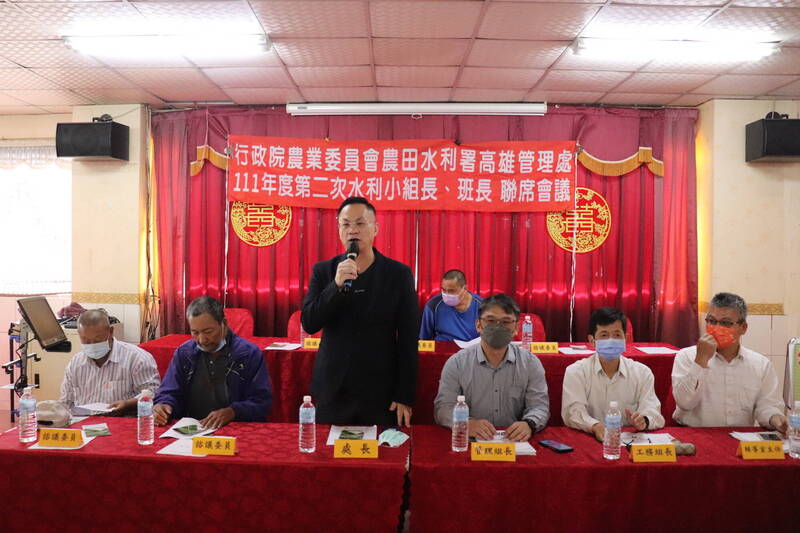Lu Wenhao, director of the Kaohsiung Management Department of the Farmland and Water Conservancy Department, said that Kaohsiung will implement rotational irrigation for the first phase of rice cultivation next year.
(Provided by the Agriculture and Water Administration)
[Reporter Chen Wenchan/Kaohsiung Report] The rainfall and river flow in Kaohsiung City this year are less than the 100-year drought. The Kaohsiung Management Office of the Farmland and Water Conservancy Department said today that it will start to strengthen irrigation management measures.
The Kaohsiung Management Office of the Farmland and Water Conservancy Department stated that the main irrigation water sources of the three major irrigation areas, such as Gaoping River and Qishan River, have seen a sharp drop in flow, which is lower than the flow in the same period at the end of 109 years before the 100-year drought. The rainfall this year is less than the average of the past 30 years. Half, if there is no rainfall, the agricultural water supply and irrigation for the first phase of rice cultivation next year will inevitably face challenges.
Please read on...
Lu Wenhao, director of the department, said that Kaohsiung does not have a large reservoir. In the face of the dry season, the senior management closely monitors the flow of rivers and implements precise irrigation. According to the growth status of crops in each irrigation area, it dynamically reviews and adjusts the water allocation. irrigation measures.
Lu Wenhao pointed out that the senior management department has deployed in advance, and has started precise irrigation since September. When there is agricultural surplus water or sufficient rainfall in the irrigation area downstream of Jiaxianyan, the water supply will be reduced or stopped, and the minimum irrigation water will be used for irrigation. Nanhua Reservoir stores water to support people's livelihood.
The senior management office successively held 5 joint meetings of team leaders and squad leaders in each irrigation district, inviting advisory committee members, water conservancy team leaders, and squad leaders to attend the joint discussion, and decided on the date of water supply and shutdown.
Recently, the flow of Qishan Stream is insufficient, and the miscellaneous cropping irrigation area has implemented large-area rotational irrigation since December 1st. The Yuemei Station irrigation area has 4 stops and 3 stops, and the Qishan Station irrigation area has 3 stops and 4 stops. The Qishan area is irrigated in turn to cope with insufficient flow.
In addition, Kaohsiung will continue to supply irrigation for the first phase of rice production next year. The Kaohsiung Management Office of the Agriculture and Water Administration will rotate irrigation from December 16 in advance, starting from the Erren Irrigation Area in Gangshan District, downstream of the Qishan River. Due to the impact of insufficient flow during the peak period of water use for the whole field, we will strive to complete full irrigation next year.
The senior management office also continues to develop new water sources. This year, 8 groundwater wells have been dug for agricultural irrigation. In addition to the original 177 groundwater wells, and 10 groundwater wells dug by the Southern District Water Resources Bureau of the Water Resources Department, they have been handed over and will be used as next year. For drought resistance use, a total of 195 groundwater wells are distributed in various irrigation areas, with a total maximum daily water output of 336,000 tons. Next year, 3 more groundwater wells will be dug to improve the drought resistance of Kaohsiung agriculture.
Lu Wenhao said that in the face of extreme climate impacts, the senior management office will make good use of its experience in drought relief over the past century, properly implement water resource allocation and response strategies according to water conditions, and immediately allocate irrigation water. Water for people's livelihood.
He said that although it will be difficult to implement rotational irrigation in the irrigation area, in order to successfully complete the first phase of irrigation next year, farmers are requested to share the difficulties, abide by the order of rotational irrigation, cooperate with the rotational irrigation measures announced by the management office, and save water.
The executive office also called on farmers to use surface water as the main irrigation water, supplemented by groundwater, in addition to the original groundwater irrigation area. If the surface water is insufficient for irrigation, groundwater will be pumped again. Groundwater is used for drought relief in Kaohsiung. Be sure to use it sparingly to prevent groundwater levels No water to pump after descent.
